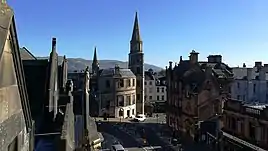Stirling
Stirling (/ˈstɜːrlɪŋ/; Scots: Stirlin; Scottish Gaelic: Sruighlea [ˈs̪t̪ɾuʝlə]) is a city in central Scotland, 26 miles (42 km) northeast of Glasgow and 37 miles (60 km) north-west of Edinburgh. The market town, surrounded by rich farmland, grew up connecting the royal citadel, the medieval old town with its merchants and tradesmen,[3] the Old Bridge and the port. Located on the River Forth, Stirling is the administrative centre for the Stirling council area, and is traditionally the county town of Stirlingshire. Proverbially it is the strategically important "Gateway to the Highlands".
Stirling
| |
|---|---|
| City and administrative centre | |
From top, left to right: Skyline of Stirling; the Wallace Monument, Stirling Old Bridge, The Athenaeum and Wallace statue; Stirling Tolbooth, Stirling Castle; View towards Burgh Buildings | |
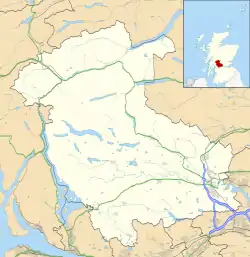 Stirling Location within the Stirling council area | |
| Area | 16.7 km2 (6.4 sq mi) [1] |
| Population | 37,910 (mid-2020 est.)[2] |
| • Density | 2,270/km2 (5,900/sq mi) |
| OS grid reference | NS795935 |
| • Edinburgh | 43 mi (69 km) |
| Civil parish |
|
| Council area |
|
| Lieutenancy area |
|
| Country | Scotland |
| Sovereign state | United Kingdom |
| Post town | STIRLING |
| Postcode district | FK7–FK9 |
| Dialling code | 01786 |
| Police | Scotland |
| Fire | Scottish |
| Ambulance | Scottish |
| UK Parliament |
|
| Scottish Parliament |
|
It has been said that "Stirling, like a huge brooch clasps Highlands and Lowlands together".[4][5] Similarly "he who holds Stirling, holds Scotland" is often quoted. Stirling's key position as the lowest bridging point of the River Forth before it broadens towards the Firth of Forth made it a focal point[6] for travel north or south.[7]
When Stirling was temporarily under Anglo-Saxon sway, according to a 9th-century legend,[8] it was attacked by Danish invaders. The sound of a wolf roused a sentry, however, who alerted his garrison, which forced a Viking retreat.[9] This led to the wolf being adopted as a symbol of the town[10] as is shown on the 1511 Stirling Jug.[11][12] The area is today known as Wolfcraig.[13] Even today the wolf appears with a goshawk on the council's coat of arms along with the recently chosen[14] motto: "Steadfast as the Rock".[15]
Once the capital of Scotland, Stirling is visually dominated by Stirling Castle. Stirling also has a medieval parish church, the Church of the Holy Rude, where, on 29 July 1567, the infant James VI was anointed King of Scots by Adam Bothwell, the Bishop of Orkney, with the service concluding after a sermon by John Knox.[16] The poet King was educated by George Buchanan and grew up in Stirling. He was later also crowned King of England and Ireland on 25 July 1603, bringing closer the countries of the United Kingdom. Modern Stirling is a centre for local government, higher education, tourism, retail, and industry. The mid-2012 census estimate for the population of the city is 36,440; the wider Stirling council area has a population of about 93,750.[17]
One of the principal royal strongholds of the Kingdom of Scotland, Stirling was created a royal burgh by King David I in 1130. In 2002, as part of Queen Elizabeth's Golden Jubilee, Stirling was granted city status.
History
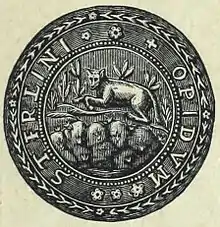
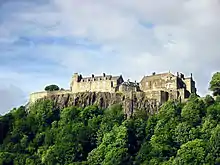

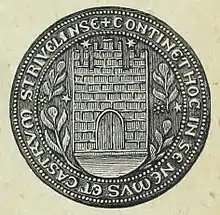
Etymology
The origin of the name Stirling[20] is uncertain,[21] but folk etymology suggests that it originates in either a Scots or Gaelic term meaning the place of battle, struggle[22] or strife.[23] One proposal is that Stirling derives from Gaelic srib-linn, meaning "stream-pool" or similar.[24] Other sources suggest that it originates in a Brythonic name meaning "dwelling place of Melyn",[25] with the first element being connected to Middle Welsh ystre-, "a dwelling".[26] The name may have originally been a hydronym, and connected to Brittonic *lïnn, "lake, pool" (Welsh llyn).[26] It is often argued that Stirling is the fortress of Iuddeu or Urbs Giudi where Oswiu of Northumbria was besieged by Penda of Mercia in 655, as recorded in Bede and contemporary annals.
Ancient history
A stone cist, found in Coneypark Nursery[27] in 1879, is Stirling's oldest catalogued artefact.[28] Bones from the cist were radiocarbon dated and found to be over four millennia old, originating within the date range 2152 to 2021 BC.[29] Nicknamed Torbrex Tam, the man, whose bones were discovered by workmen, died while still in his twenties.[30] Other Bronze Age finds near the city come from the area around Cambusbarron.[31] It had been thought that the Randolphfield standing stones were more than 3000 years old but recent radiocarbon dating suggests they may date from the time of Bruce.[32] The earliest known structures in Stirling are now destroyed but comprised two Neolithic Cursus in Bannockburn.[33] The earliest known surviving structure is a fort on Gillies Hill[34] were built by Iron Age people over 2000 years ago. Two structures are known: what is currently called Wallstale Dun[35] on the southern end of Touchadam Craig, and Gillies Hill fort[36] on the northwest end of the craig. The Wallstale structure is later than the Gillies Hill fort and is related in form to brochs, these appear to coincide with the Roman period and there are around 40 or so in the wider area. South of the city, the King's Park prehistoric carvings can still be found.[37]
Roman and early Medieval
Its other notable geographic feature is its proximity to the lowest site of subjugation of the River Forth. Control of the bridge brought military advantage in times of unrest and excise duty, or pontage dues,[38] in peacetime. Unsurprisingly excise men were installed in a covered booth in the centre of the bridge to collect tax from any entering the royal burgh with goods.[39] Stirling remained the river's lowest reliable crossing point (that is, without a weather-dependent ferry or seasonal ford[40]) until the construction of the Alloa Swing Bridge between Throsk and Alloa in 1885.[41]
The city has two Latin mottoes, which appeared on the earliest burgh seal[42] of which an impression of 1296 is on record.[43] The first alludes to the story as recorded by Boece who relates that in 855 Scotland was invaded by two Northumbrian princes, Osbrecht and Ella.[44] They united their forces with the Cumbrian Britons[45] in order to defeat the Scots. Having secured Stirling castle, they built the first stone bridge over the Forth.
On the top they reportedly raised a crucifix with the inscription: "Anglos, a Scotis separat, crux ista remotis; Arma hic stant Bruti; stant Scoti hac sub cruce tuti."[46] Bellenden translated this loosely as "I am free marche, as passengers may ken, To Scottis, to Britonis, and to Inglismen." It may be the stone cross was a tripoint for the three kingdom's borders or marches;[47] the cross functioning both as a dividing territorial marker, and as a uniting[48] witness stone like in the Bible story in Joshua 22.[49] "Angles and Scots here demarked, By this cross kept apart. Brits and Scots armed stand near, By this cross stand safe here." This would make the cross on the centre of the first stone bridge the Heart of Scotland.
The Stirling seal has only the second part, in a slightly different form:
- Hic Armis Bruti Scoti Stant Hic Cruce Tuti
- (Brits and Scots armed and near, by this cross stand safe here.)
Apparently the Latin is not first rate having four syllables in "cruce tuti" but the meaning seems to be that the Lowland Strathclyde Britons on the southern shore and the Highland Pictish Scots[50] on the northern shore stand protected from each other by their common Christianity.[51]
A more modern translation suggests that rather than Briton, bruit might be better read as brute, ie brute Scots, implying a non-Scots identity was retained in Stirling for some time after inclusion into the land controlled by the King of Scots. This more likely happened around 1000 AD.
The second motto is:
- Continet Hoc in Se Nemus et Castrum Strivelinse
- (Contained within this seal pressed down, the wood an' castle o' Stirlin' town.)
It has been claimed that the "Bridge" seal was regarded as the Burgh seal proper, the "Castle" seal being simply a reverse, used when the seal was affixed by a lace to a charter.[52] This agrees with a description in an official publication (which spells[53] Bruti with only one letter t).[54] Clearer images are available[55] with different lettering.[56] Sibbald conflated the two mottos into a single rhyme;[57] he gave no indication that he was aware of Boece's work.[58]
Stirling was first declared a royal burgh by King David in the 12th century, with later charters reaffirmed by subsequent monarchs. A ferry, and later bridge, on the River Forth at Stirling brought wealth and strategic influence, as did its tidal port at Riverside.[59] Major battles during the Wars of Scottish Independence took place at the Stirling Bridge in 1297 and at the nearby village of Bannockburn in 1314 involving William Wallace and Robert the Bruce respectively. After the Battle of Stirling Bridge, Wallace wrote to the Hanseatic leaders of Lübeck and Hamburg to encourage trade between Scottish ports (like Stirling) and these German cities.[60] There were also several Sieges of Stirling Castle in the conflict, notably in 1304.[61]
Late Medieval and early Modern
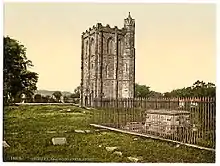
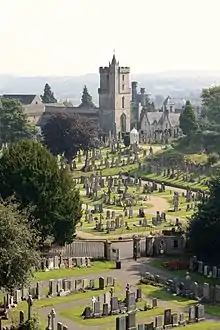
Another important historical site in the area is the ruins of Cambuskenneth Abbey, the resting place of King James III of Scotland and his queen, Margaret of Denmark.[63] The king died at the Battle of Sauchieburn by forces nominally led by his son and successor James IV. During the Wars of the Three Kingdoms, the Battle of Stirling also took place in the centre of Stirling on 12 September 1648. The fortifications continued to play a strategic military role during the 18th-century Jacobite risings. In 1715, the Earl of Mar failed to take control of the castle. In January 1746, the army of Bonnie Prince Charlie seized control of the town but failed to take the Castle. On their consequent retreat northwards, they blew up the church of St. Ninians where they had been storing munitions; only the tower survived and can be seen to this day.[64] The castle and the church are shown on Blaeu's map[65] of 1654 which was derived from Pont's earlier map.[66]
Standing near the castle, the Church of the Holy Rude is one of the town's most historically important buildings. Founded in 1129 it is the second oldest building in the city after Stirling castle. It was rebuilt in the 15th-century after Stirling suffered a catastrophic fire in 1405, and is reputed to be the only surviving church in the United Kingdom apart from Westminster Abbey to have held a coronation.[67] On 29 July 1567 the infant son of Mary, Queen of Scots, was anointed James VI of Scotland in the church.[67] James' bride, Anne of Denmark was crowned in the church at Holyrood Palace in Edinburgh. The Holy Rude congregation still meet and some 19th century parish records survive.[68] Musket shot marks that may come from Cromwell's troops during the Wars of the Three Kingdoms are clearly visible on the tower and apse of the church.[67]
Economically, the city's port supported foreign trade, historically doing significant trade in the Low Countries, particularly with Bruges[69] in Belgium and Veere[70] in the Netherlands. In the 16th century there were so many Scots in Danzig[71] in Prussia that they had their own church congregation and trade is mentioned with that city in Stirling Council's minutes of 1560.[72] Around John Cowane's time there is an account which states there were about 30,000 Scots families living in Poland[73] although that was possibly[74] an exaggeration.[75] Trade with the Baltic[76] also took place such as a timber trade with Norway.
.jpg.webp)
After the Jacobite threat had faded but before the railways were established, the Highland cattle drovers would use the Auld Brig on their way to market at Falkirk[77] or Stenhousemuir.[78] Three times a year, tens of thousands of cattle, sheep and ponies were moved together to the trysts in the south with some drovers going as far as Carlisle or even London's Smithfield.[79] There is a record of a four-mile long tailback (of livestock) developing from St. Ninians to Bridge of Allan after a St. Ninians tollman had a dispute.[80]
Victorian and Modern
.jpg.webp)
In the early 19th century an "exceedingly low" cost steamboat service used to run between Stirling and Newhaven or Granton.[81] The coming of the railways in 1848 started the decline of the river traffic,[82] not least because the Alloa Swing Bridge downstream restricted access for shipping. The railways did provide opportunity too with one Riverside company selling their reaping machines as far afield as Syria and Australia. Similarly, in 1861, a company making baby carriages was set up. These prams were exported to Canada, South America, India and South Africa.[83]
The Princes Street drill hall was completed in 1908[84] and the Municipal Buildings, which formed the headquarters of Stirling Burgh Council for much of the 20th century, were completed in 1918.[85]
After the blockades of the World Wars there was some increase in the use of the port including a tea trade with India. However, with normal shipping lanes open, the growth of the railways including The Forth Rail Bridge, left the harbour uneconomical and by the mid 20th century the port had ceased to operate.
Governance
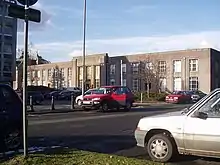
In terms of local government, the city of Stirling is a part of the wider Stirling Council area, which is based at Old Viewforth and governs on matters of local administration as set out by the Local Government etc (Scotland) Act 1994. The current members of the Council were voted in 2017 for a term of office of 5 years. The May 2017 local government election resulted in the Scottish Conservative party and Scottish National Party each winning nine councillors, while the Labour Party won four seats and the Scottish Green Party won one.[86] However, subsequently one Conservative councillor left the party to sit as an Independent.[87] The Provost of Stirling is Cllr Christine Simpson.[88]
For the purposes of the Scottish Parliament, the city of Stirling forms part of the Stirling constituency of the Scottish Parliament constituency. The Stirling Scottish Parliament (or Holyrood) constituency created in 1999 is one of nine within the Mid Scotland and Fife electoral region. Each constituency elects one Member of the Scottish Parliament (MSP) by the first past the post system of election, and the region elects seven additional members to produce a form of proportional representation. The constituency's Member of the Scottish Parliament (MSP) is Evelyn Tweed of the Scottish National Party (SNP).[89]
In terms of national government, the city of Stirling forms part of county constituency of Stirling constituency of the House of Commons, electing one Member of Parliament (MP) to the House of Commons of the parliament of the United Kingdom by first past the post system. Alyn Smith of the SNP is the MP for Stirling constituency of the House of Commons since the 2019 general election.[90]
Historical voting records can be found in online databases.[91]
Geography
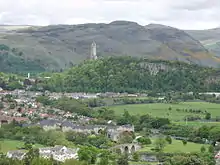
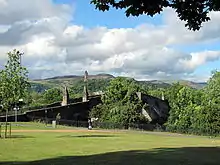
Stirling is renowned as the Gateway to the Highlands and is generally regarded as occupying a strategic position at the point where the flatter, largely undulating Scottish Lowlands meet the rugged slopes of the Highlands along the Highland Boundary Fault.[92][93] The starkness of this contrast is evidenced by the many hills and mountains of the lower Highlands such as Ben Vorlich and Ben Ledi which can be seen to the northwest of the city. On the other hand, the Carse of Stirling, stretching to the west and east of the city, is one of the flattest and most agriculturally productive expanses of land in the whole of Scotland.
The land surrounding Stirling[94] has been most affected by glacial erosion and deposition. The city itself has grown up around its castle which stands atop an ancient quartz-dolerite sill, known as the Stirling Sill, a major defensive position which was at the lowest crossing point on the River Forth. Stirling stands on the Forth at the point where the river widens and becomes tidal. To the east of the city the Ochil Hills dominate the skyline with the highest peak in the range being Ben Cleuch, although Dumyat is more noticeable from Stirling. The Ochils meet the flat carse (floodplain) of the River Forth to the east of the distinctive geographical feature of Abbey Craig, a crag and tail hill upon which stands the 220 ft (67 m) high National Wallace Monument.[95]
Areas of Stirling
Top of the Town consists of Broad Street, Castle Wynd, Ballengeich Pass, Lower Castle Hill Road, Darnley Street, Baker Street ( formerly Baxters St), St John Street and St Mary's Wynd. These streets all lead up to Stirling Castle and are the favourite haunt of tourists who stop off at the Old Town Jail, Mar's Wark, Argyll's Lodging and the castle. Ballengeich Pass leads to the graveyard at Ballengeich and the Castle Wynd winds past the old graveyard. The Top of the Town from Broad Street upwards is renowned for its cobblestoned roads, and cars can be heard rattling over the cobblestones on the way down. Craft shops and tourist-focused shops are evident on the way up and once at the top, panoramic views are available across Stirling and beyond.
All areas[96]
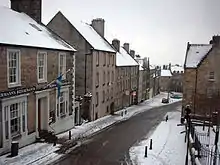
- Abbey Craig
- Airthrey
- Allan Park
- Back o' Hill
- Bannockburn
- Borestone
- Braehead
- Bridgehaugh
- Broomridge
- Brucefields
- Burghmuir
- Cambusbarron
- Cambuskenneth
- Causewayhead
- Chartershall
- Corn Exchange
- Cornton
- Coxethill
- Craigforth
- Craigmill
- Craig Leith
- Cultenhove
- Dumyat
- Forthbank
- Gillies Hill
- Gowan Hill
- Hillpark
- Kenningknowes
- Kersemill
- Kildean
- King's Park
- Ladyneuk
- Laurelhill
- Livilands
- Loanhead
- Logie
- Mote Hill
- Meadowforth
- Mercat Cross
- Pirnhall
- Queenshaugh
- Raploch
- Randolphfield
- Riverside
- Spittal Hill
- Springkerse
- St. Ninians
- Top of the Town
- Torbrex
- Whins of Milton
- Viewforth
- Westhaugh
- Wolfcraig
Historical place names for Stirling town in 1858–61 were compiled by O.S. map makers.[97]
Climate
Like most of the United Kingdom, Stirling has an oceanic climate (Köppen Cfb) with mild summers and cool, wet winters. Stirling has some of the warmest summers in all of Scotland, being relatively far away from the cooling effects of the North Sea and the Firth of Clyde.
| Climate data for Stirling (1991–2020 averages, extremes 2009–present, [25 m or 82 ft asl]) | |||||||||||||
|---|---|---|---|---|---|---|---|---|---|---|---|---|---|
| Month | Jan | Feb | Mar | Apr | May | Jun | Jul | Aug | Sep | Oct | Nov | Dec | Year |
| Record high °C (°F) | 13.6 (56.5) |
15.5 (59.9) |
17.1 (62.8) |
21.1 (70.0) |
27.8 (82.0) |
32.3 (90.1) |
29.0 (84.2) |
24.9 (76.8) |
23.8 (74.8) |
19.7 (67.5) |
15.7 (60.3) |
14.5 (58.1) |
32.3 (90.1) |
| Average high °C (°F) | 7.3 (45.1) |
8.1 (46.6) |
9.9 (49.8) |
12.4 (54.3) |
15.7 (60.3) |
18.1 (64.6) |
19.9 (67.8) |
19.5 (67.1) |
17.1 (62.8) |
13.5 (56.3) |
10.0 (50.0) |
7.5 (45.5) |
13.3 (55.9) |
| Daily mean °C (°F) | 4.4 (39.9) |
5.0 (41.0) |
6.4 (43.5) |
8.3 (46.9) |
11.3 (52.3) |
14.0 (57.2) |
15.7 (60.3) |
15.3 (59.5) |
12.9 (55.2) |
9.8 (49.6) |
6.7 (44.1) |
4.3 (39.7) |
9.5 (49.1) |
| Average low °C (°F) | 1.4 (34.5) |
1.9 (35.4) |
2.9 (37.2) |
4.3 (39.7) |
6.9 (44.4) |
9.8 (49.6) |
11.5 (52.7) |
11.1 (52.0) |
8.8 (47.8) |
6.2 (43.2) |
3.5 (38.3) |
1.1 (34.0) |
5.8 (42.4) |
| Record low °C (°F) | −11.1 (12.0) |
−7.6 (18.3) |
−5.8 (21.6) |
−3.9 (25.0) |
−1.7 (28.9) |
3.6 (38.5) |
5.0 (41.0) |
3.8 (38.8) |
1.0 (33.8) |
−2.8 (27.0) |
−6.6 (20.1) |
−15.6 (3.9) |
−15.6 (3.9) |
| Average rainfall mm (inches) | 129.3 (5.09) |
97.3 (3.83) |
74.5 (2.93) |
51.4 (2.02) |
56.9 (2.24) |
66.6 (2.62) |
70.1 (2.76) |
76.1 (3.00) |
76.3 (3.00) |
107.4 (4.23) |
109.2 (4.30) |
103.1 (4.06) |
1,018.1 (40.08) |
| Average rainy days (≥ 1 mm) | 16.3 | 13.6 | 12.8 | 10.6 | 11.3 | 11.7 | 13.0 | 13.0 | 12.6 | 15.2 | 16.1 | 15.4 | 161.4 |
| Mean monthly sunshine hours | 39.1 | 66.9 | 99.5 | 137.8 | 183.1 | 162.0 | 153.7 | 150.5 | 119.5 | 81.3 | 54.0 | 32.2 | 1,279.6 |
| Source 1: MetOffice[98] | |||||||||||||
| Source 2: [99] | |||||||||||||
Demography
The settlement of Stirling had a population of 48,440 in 2012. According to the 2001 census, 52.7% of the population was female compared to 47.2% male. Stirling had both a smaller proportion of under 16s, at 16.7% compared to the Scottish average of 19.2%, and a smaller proportion of those of pensionable age: 17.8% – compared to the Scottish average of 18.6%.[100] The highest proportion of the population, at 24.3%, was concentrated in the 16–29 age group. Stirling also had a higher proportion of non-Scottish born residents at 16.5%, compared to the Scottish average of 12.8%. The population was also slightly younger than the Scottish average of 37 – the median age for males was 34; and the median age for females was 36, to the national average of 39. The population peaks and troughs significantly when the students come and go from the city.
Historical records also exist both in book form[69] and in online databases.[101]
Culture

Walking the Marches[47] is a custom probably started in the 12th century. The only way the town's boundaries could be protected was to walk round inspecting them annually. The walk was followed by a dinner.[102] This was traditionally done by the Birlaw men made up from members of the Seven Trades, the Guildry and Council. In 2014 the tradition was revived after an official abeyance of several years.[103]
There are about sixteen libraries and two mobile libraries in Stirling.[104] The Smith Art Gallery and Museum is now free to tourists and residents alike. Shearer's 1895 Penny Guide to Stirling and Neighbourhood used to list it under "How to spend a few hours on a wet day".[105] The Macrobert Arts Centre has a variety of exhibitions and performances. There are many events at the Stirling Tolbooth and at The Albert Halls.[106] Stirling has hosted the National Mòd several times: in 1909, 1961, 1971,1987 and 2008.[107]
In October 2021, Stirling was longlisted as the only Scottish bid for the UK City of Culture 2025, but failed to make it onto the March 2022 shortlist.[108]
Religion
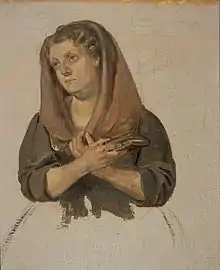
There are currently about 20 churches in the city. These include:
Church of Scotland[110]
- Allan Park South Church[111]
- Cambusbarron Parish Church[112]
- Church of the Holy Rude[113]
- North Parish Church[114]
- St Columba's Church[115]
- St Mark's Parish Church[116]
- St Ninians Old Parish Church[117]
- Viewfield Church[118]
Roman Catholic[119]
- Holy Spirit, St. Ninians[120]
- Our Lady and St Ninian's, Bannockburn[121]
- St Margaret of Scotland and Holy Spirit, Raploch[122]
- St Mary's Church, Top of the Town[123]
Other churches
- Cornerstone Community Church[124]
- Cornton Baptist Church[125]
- Holy Trinity Episcopal Church[126]
- St Ninians United Free Church of Scotland[127]
- Stirling Baptist Church[128]
- Stirling Free Church[129]
- Stirling Methodist Church[130]
- St. Ninian's Community Church[131]
- The Salvation Army[132]
Islam
- Central Scotland Islamic Centre[133]
Economy
.jpg.webp)
At the centre of a large rural agricultural hinterland that encompasses some of the flattest and most productive land in Scotland, Stirling principally functioned as a market town, symbolised by its Mercat cross, with farmers coming to sell their products and wares in the large agricultural market that was held in the town. Today, agriculture still plays a part in the economic life of Stirling, given its focus at the heart of a large rural area, but to a much lesser extent than previously.
With Stirling's development as a market town and its location as the focus of transport and communications in the region, it has developed a substantial retail sector serving a wide range of surrounding communities as well as the city itself. Primarily centred on the city centre, there are a large number of chain stores, as well as the Thistles shopping centre. However this has been augmented by out-of-town developments such as the Springkerse Retail Park on the city bypass to the east of Stirling, and the development of a large Sainsbury's in the Raploch.
A major new regeneration project on the site of the former port area and the 40-acre (160,000 m2) former Ministry of Defence site, adjacent to Stirling Railway Station, is currently underway.[134] Known as Forthside, it has the aim of developing a new waterfront district linked to the railway station via Forthside Bridge. The development comprises retail, residential and commercial elements, including a conference centre, hotel and Vue multiplex cinema, that will ultimately expand the city centre area, linking it to the River Forth, which has been cut off from the city centre area since the construction of the A9 bypass under the railway station in the 1960s.[135] For the first time in 100 years, local people will have access to the banks of the River Forth in the city centre with landscaped public areas, footpaths, cycleways and an improved public transport network.

In the service sector, financial services as well as tourism are the biggest employers. The financial services and insurance company Prudential have a large and well-established base at Craigforth on the outskirts of Stirling. In terms of tourism, the presence of such historical monuments as Stirling Castle, the National Wallace Monument and other nearby attractions like Blair Drummond Safari Park, the key role which Stirling has played in Scottish history, as well as the scenery of the area, has bolstered Stirling's position as an important tourist destination in Scotland.
The University of Stirling and Stirling Council are two of the biggest employers in the area. Knowledge related industries, research and development as well as life sciences have clustered around the university in the Stirling University Innovation Park, close to its main campus. Other public sector agencies that are major employers in the city include Police Scotland, Scottish Prison Service, NHS Forth Valley and the Scottish Environment Protection Agency.
Mauchline ware started producing wooden snuff-boxes in 1790 in Mauchline, Ayrshire. They were produced of the wood from the trees from the Castle craig. Today they are highly collectible.[136]
Stirling is home to national construction companies Ogilvie Group, chaired by Duncan Ogilvie, who is listed in the Times Rich List as being worth £35 million.
A Bank of Scotland survey in 2009 found that workers in Stirling had the highest average earnings of £716 a week.[137]
Transport
.jpg.webp)
The City of Stirling is home to a large number of commuters but has fewer commuting to work in other areas, than travel into the city. About half of Scotland's population live within an hour's travel time of Stirling.[138]
Local bus services to districts within the city are almost completely provided by buses operated by McGill's Scotland East. The surrounding towns, like Bridge of Allan, Alloa, Falkirk and Glasgow via Cumbernauld have services from the bus station.
Coaches to many Scottish towns and cities also run regularly.[139]
There are also railway links from Stirling railway station, including inter-city rail services to Aberdeen, Dundee, Edinburgh Waverley, Inverness, Glasgow Queen Street, and London King's Cross. Services to Alloa, Bridge of Allan, Falkirk and Dunblane also run. Stirling Council provides some approximate journey times.[140] Working lines include the Highland Main Line, the Edinburgh–Dunblane line and the Croy Line. The station formerly provided direct railway services to Callander and Oban, and to Loch Lomond, over very scenic lines, and a fast service to Dunfermline.
Cities with motorways links close to Stirling include Glasgow, via the M80 motorway past Cumbernauld, and Edinburgh, via the M9 motorway past Falkirk. To the north, the M9 provides access to Dunblane with easy links to Perth and further beyond the Central Belt.
Stirling has no airport, but there are international airports at Glasgow and Edinburgh which can be reached within an hour. Light aircraft can be chartered at Cumbernauld Airport.
Stirling used to have steamboats which carried hundreds of passengers a day.[82] There is currently no working port at Stirling but there are plans to develop the river[141] and the harbour[142] which might include links with towns on the Firth of Forth. Since the Forth is tidal at Stirling, development of pontoon style landing stages could potentially allow river taxis and tourist boats to operate during the summer.[143]
Sports and recreation
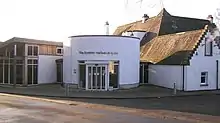
Stirling is home to professional league teams in football, rugby and cricket.
Marathon
The first Stirling Scottish Marathon was held on 21 May 2017.[144]
Curling
The National Curling Academy is located in Stirling Sports Village.[145] It was opened in 2017 by Eve Muirhead.[146] They use facilities linked to The Peak.[147] It was hoped this would increase the chances of British medals at events like the Winter Olympics and Paralympics.[148]
Men
The senior football team, Stirling Albion, play in the Scottish League Two at their home ground at Forthbank Stadium. In July 2010, the Stirling Albion Supporters' Trust successfully took over the running of the club buying out the long-serving chairman, Peter McKenzie, after 14 months of campaigning. This made Stirling Albion the first fully owned community club in the history of British football, after previous attempts made by Manchester United, Liverpool and Rangers.[149]
Women
Stirling University L.F.C. are the premier women's football team. They play in the Scottish Women's Premier League. Their home ground is The Gannochy Sports Centre at Stirling University.[150]
Rugby
Stirling County currently play in rugby's Scottish Premiership Division One.
Basketball
Stirling Knights Basketball Team are based at the Peak at Forthbank beside Forthbank Stadium.[151]
Athletics
The athletics team Central Athletic Club are based at the University of Stirling.
Hockey
The University Stirling Wanderers Hockey Club have also moved to a brand new (international standard) pitch at Forthbank for season 2008–09.[152]
Cricket
Next to this pitch there is also the ground of Stirling County Cricket Club, whose pavilion captured an architectural award in June 2009,[153] three years after its opening.
Scotland international footballers Billy Bremner, John Colquhoun, Duncan Ferguson, female footballer Frankie Brown and brothers Gary and Steven Caldwell were born in Stirling. So were rugby internationals Kenny Logan, Allister Hogg and Alison McGrandles, jockey Willie Carson, and cricketer Dougie Brown.
The University of Stirling is a major centre of sports training and education in Scotland. It was designated as Scotland's University for Sporting Excellence by the Scottish Government in 2008. The headquarters of the Scottish Institute of Sport is a purpose-built facility on the campus which opened in 2002. Also at the university is the Scottish National Swimming Academy, where Rio 2016, Olympic silver medalists and students at the university, Duncan Scott and Robbie Renwick trained. Commonwealth gold medalist Ross Murdoch, who also competed at Rio 2106, is a student at the university. The Gannochy National Tennis centre, which is seen as a tennis centre of excellence, was where Andy Murray and his brother Jamie Murray honed their skills as juniors. Gordon Reid, wheel chair Olympic gold medalist in 2016, was a tennis scholar at the university.[154] The university men's and women's golf teams are consistently ranked among the best in Europe.[155]
The university has a dedicated sports studies department, which is within the Faculty of Health Science and Sport, and is ranked amongst the best in the United Kingdom for its provision of sports facilities, with the maximum 5-star award, shared by 16 other universities in the UK.[156] The University of Stirling also currently hosts the Scottish men's lacrosse champions.
Stirling and its surrounding area has a number of 9- and 18-hole golf courses, the largest of which is the Stirling Golf Course, located in the Kings Park area of the city. The Peak, a new Sports Village, was opened in April 2009 to cater for a range of sporting activities.[157]
In June 2014, Stirling will become the home of Scottish cricket after an agreement between Stirling County Cricket Club, Cricket Scotland and Stirling Council. It is hoped that the redevelopment of the ground will start at end 2014 with the intention being to upgrade it to international match standards. Scotland will play the majority of their home international games at the ground, starting with the World T20 qualifiers in the summer of 2015.
The development will see a new pavilion and indoor training facility built at New Williamfield, the home of Stirling County Cricket Club, with Cricket Scotland relocating its headquarters from the National Cricket Academy at Ravelston, Edinburgh.[158]
Education
The University of Stirling opened in 1967 on a greenfield site outside the town. Currently there are 11,100 students studying at the university, of which 7,995 are undergraduates and 3,105 are postgraduates. There are 120 nationalities represented on the university campus, with 19% of students coming from overseas.[159] It has grown into a major research centre, with a large Innovation Park located immediately adjacent to the main university campus. Innovation Park has grown since its initiation in 1993, and is now home to 40 companies engaging in various forms of research and development.[160] In January 2008 it was announced that students from Singapore would be able to gain degrees in retail from the University of Stirling in a tie-up with the country's Nanyang Polytechnic (NYP).[161]
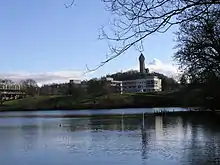
Stirling is also home to part of the wider Forth Valley College which was formed on 1 August 2005 from the merger of Falkirk, Stirling and Clackmannan colleges.
There are four main high schools in Stirling itself – Stirling High School, with a school roll of 964 pupils, Wallace High School with 958 pupils, St Modan's High School with 912 pupils, and Bannockburn High School in Broomridge with 752 pupils.[162][163][164][165] All the city's secondary school premises have been redeveloped as a result of a Public-private partnership scheme. Stirling also has a Gaelic-medium unit situated in the city's Riverside Primary School which teaches pupils from across Stirling and Clackmannanshire through the medium of Scottish Gaelic.[166]
In popular culture
- Stirling: Gateway to the Highlands[167] (1938) B&W 20 mins silent – video 1: Street scenes from Stirling. video 2: pre-WW2 soldiers at the castle.
- Stirling Charities Day[168] (13 May 1939) B&W 7 mins silent – Includes shots of kids, costumes and carriages.
- Neighbours[169] – (1952) violent Oscar winning animation by the Stirling-born Canadian film maker Norman McLaren.
- River Forth[170] (1956) B&W silent 15 mins – Including animals being herded through the streets.
- The Heart of Scotland[171] (1962) colour sound 24 mins – Shots of the castle with commentary on Bruce and Wallace.
- Holiday Scotland[172] (1966) colour and sound 42 mins – Includes Stirling Castle and Stirling Bridge.
- Kidnapped[173] (1971) dir. Delbert Mann – Starring Michael Caine – with several scenes in Stirling Castle.
- Royal Stirling[174] (1972) colour and sound 23 mins – Includes a lion cub at the castle, motor racing and shots of Blair Drummond Safari Park
- The University of Stirling[175] (1973) colour and sound 19 min – 1970s campus, students and teachers (includes Norman MacCaig).
- FutureWorld Stirling 1984[176] (1984) 28 minutes – dir. Peter G. Reilly for Stirling District Council – has Magnus Magnusson explaining ambitious plans for the Top of the Town. It is more of a series of pieces to camera than Cumbernauld, Town for Tomorrow, as Magnusson moves from the Smith through various well-known but dilapidated buildings to Gowan Hill and back to the castle. At each stop he presents John W. Morgan's script which gives something of the history or the proposed plans for revitalising the area.
- Gregory's Two Girls[177] (1999) dir. Bill Forsyth – has scenes at and around Stirling Castle.
- To End all Wars[178] (2001) dir. David L. Cunningham has scenes at Stirling Castle.
- Way Back Home (2010) Has Danny MacAskill perform stunts on his bike on Stirling Bridge.[179]
- KJB: The Book That Changed the World (2011) Has John Rhys-Davies narrating scenes about James VI at Stirling Castle.[180]
- Britain's Lost Routes with Griff Rhys Jones (2012) Episode 3 shows the difficulties "Highland Cattle Drovers" might have had at Frew and shows aerial shots and taking cows across the Auld Brig.[181]
- Secrets of Great British Castles (2015) Dan Jones presents the History of Stirling Castle up to James VI.[182]
- Netflix drama Outlaw King[183] had scenes filmed at Mugdock Country Park with a production/support team camped at Falleninch Field, situated beneath Stirling Castle.
Twinned cities
Notable residents
- Dorothy Angus – embroidery artist
- Frank and Harold Barnwell – pilots and aircraft designers
- Frank Beattie – footballer
- Alexander Beith - Moderator of the General Assembly of the Free Church of Scotland
- Billy Bremner – former Leeds and Internationalist footballer
- Sir Henry Campbell-Bannerman – former Prime Minister
- Gary Caldwell – Former Scotland International footballer and manager.
- Steven Caldwell – footballer
- Willie Carson – jockey[185]
- Duncan Ferguson – footballer
- Robert Garnock – Covenanter, hanged in Edinburgh
- John Grierson – documentary film pioneer
- James Guthrie – minister and Protester
- Michael Hay – lawyer
- Thomas Hamilton, mass murderer responsible for the Dunblane massacre
- Gail Honeyman – novelist[186]
- King James VI of Scotland – former resident
- Stephen Kingsley – footballer
- John Joseph Jolly Kyle – pioneer chemist
- Christian Maclagan – Sunday School teacher, antiquarian, early archaeologist, and suffragist
- Bill Macnaught - National Librarian of New Zealand, 2011–2020
- Mary, Queen of Scots – former resident
- Mirren Mack – actress
- Muir Mathieson – film music composer
- Lauren Mayberry – musician
- John McAleese – team leader during the SAS assault on the Iranian embassy in May 1980[187][188]
- Norman McLaren – animation pioneer
- Neil Oliver – television presenter
- John Paton – Victoria Cross recipient
- Patrick Simson – minister respected by James VI
- Anna Sloan – Olympic curler, bronze medalists at the 2014 Winter Olympics[189]
- Kirsty Young – television presenter
Freedom of the City
The following people and military units have received the Freedom of the City of Stirling.
Individuals
- HRH Duke of York: 29 August 1928.
- HRH Duchess of York: 29 August 1928.[190]
- HRH Duchess of Edinburgh: 1948.
- Lieutenant Colonel Francis William Saunders MBE ERD: 17 July 2008.[191]
- Irvin Iffla: 3 April 2009.[192]
- Sir Andrew Murray OBE: 22 April 2014.[193]
See also
- Black Bond
- Lecropt
- List of places in Stirling (district)
- List of places in Scotland
- Stirling City Choir
- List of town defences in Scotland
References
- "Stirling (Stirling, Scotland, United Kingdom) – Population Statistics, Charts, Map, Location, Weather and Web Information". www.citypopulation.info. Archived from the original on 28 March 2019. Retrieved 28 March 2019.
- "Mid-2020 Population Estimates for Settlements and Localities in Scotland". National Records of Scotland. 31 March 2022. Retrieved 31 March 2022.
- Drysdale, William (1898). Old faces, old places, and old stories of Stirling. E. Mackay. pp. 292–303. Retrieved 5 April 2017.
- Durie, Bruce (2014). The Story of Stirling. History Press. p. 27. ISBN 978-0-7509-6040-3.
- Smith, Alexander (1865). A summer in Skye. London: Sampson Low, Marston. Retrieved 6 April 2017.
- Ronald, James (1897). The Merchants' guide book to Stirling and district. Stirling: E. MacKay. pp. 38–40.
- Stair-Kerr, Eric (1913). Stirling Castle: its place in Scottish history. Glasgow: James Maclehose and Sons. p. 159. Retrieved 5 April 2017.
- Groome, Francis H. "Ordnance Gazetteer of Scotland: A Survey of Scottish Topography, Statistical, Biographical and Historical". Gazetteer for Scotland. Thomas C. Jack, Grange Publishing Works. Archived from the original on 6 April 2017. Retrieved 5 April 2017.
- Nimmo, William; Gillespie, Robert (1880). The history of Stirlingshire (3rd ed.). Glasgow: Thomas D. Morison. pp. 63–65 & 368–369. Retrieved 5 April 2017.
- "Stirling (Scotland)". Archived from the original on 4 April 2017. Retrieved 3 April 2017.
- "The Stirling Jug". The Smith Art Gallery and Museum. Archived from the original on 14 April 2017. Retrieved 13 April 2017.
- Sommerville, James (1791). The statistical account of Scotland. Vol. 8. Edinburgh: W. Creech. pp. 271-296.
- "The Wolfcraig, Stirling – Cameraman". Blipfoto. Archived from the original on 11 December 2017. Retrieved 11 December 2017.
- "Stirling reveals new motto after vote". BBC News. Archived from the original on 28 May 2017. Retrieved 3 April 2017.
- "Coat of Arms". Stirling Council. Archived from the original on 4 April 2017. Retrieved 3 April 2017.
- Stair-Kerr, Eric (1913). Stirling Castle: its place in Scottish history. Glasgow: James Maclehose and Sons. p. 79. Retrieved 5 April 2017.
- "Population estimates". Stirling Council. Archived from the original on 7 November 2017. Retrieved 4 November 2017.
- John, Marquess of Bute; Lonsdale, H. W.; MacPhail, J. R. N. (1897). The Arms of the Royal and Parliamentary Burghs of Scotland. Edinburgh: William Blackwood & Sons. p. 368. Retrieved 11 April 2017.
- Penny Guide to Stirling, Stirling Castle, Wallace Monument, Bannockburn, Etc. R.S. Shearer. 1895. p. 23. Retrieved 5 April 2017.
- Cupples, George (1845). "Stirling". The new statistical account of Scotland. Edinburgh and London: W. Blackwood and Sons. pp. 390–453.
- Drysdale, William (1898). Old faces, old places, and old stories of Stirling. Stirling: E. Mackay. p. 299. Retrieved 5 April 2017.
- Jamieson, John; Brown, William (1830). Select Views of the Royal Palaces of Scotland: from drawings by William Brown Glasgow : with illustrative descriptions of their local situation, present appearance and antiquities. Edinburgh: Cadell & Co. pp. 144–147. Retrieved 13 April 2017.
- Mackie, Charles (1835). The castles of Mary, Queen of Scots; being a historical description of every castellated erection which formed a residence or a prison to that Queen. Embellished with engravings from original drawings by G.F. Sargent (3rd ed.). London: T. Tegg. p. 41. Retrieved 8 April 2017.
- Clancy, Thomas Owen. "The Etymologies of Pluscarden and Stirling" (PDF). Clann Tuirc. University of Glasgow. Retrieved 1 July 2019.
- Iain Taylor. "Place names" (PDF). Archived (PDF) from the original on 5 July 2013. Retrieved 24 April 2013.
- James, Alan. "A Guide to the Place-Name Evidence" (PDF). SPNS – The Brittonic Language in the Old North. Archived from the original (PDF) on 13 August 2017. Retrieved 25 November 2018.
- "OS 25 inch map 1892–1949, with Bing opacity slider". National Library of Scotland. Ordnance Survey. Archived from the original on 30 November 2012. Retrieved 12 October 2017.
- Historic Environment Scotland. "Cairn (Period Unassigned), Cist(S) (Period Unassigned), Beaker (46189)". Canmore. Retrieved 11 February 2017.
- McNeill, Alastair (1 November 2017). "Stirling's oldest resident revealed to be 4000-year-old 'Torbrex Tam'". Daily Record. Archived from the original on 4 November 2017. Retrieved 3 November 2017.
- Hutchison, A.F. (1898). Transactions 1878–1879. Stirling: Stirling Field Club (now Stirling Natural History and Archaeological Society). pp. 13–22. Retrieved 4 November 2017.
- Paterson, P. T. "Byegone Days of Cambusbarron". cambusbarron dot com. Archived from the original on 8 April 2017. Retrieved 7 April 2017.
- "'Ancient' standing stones are linked to 1314 battle". The Herald. Herald & Times Group. 30 December 2016. Archived from the original on 8 April 2017. Retrieved 7 April 2017.
- "Bannockburn West". Retrieved 21 May 2020.
- "Atlas of Hillforts". Archived from the original on 14 October 2017. Retrieved 14 October 2017.
- "Wallstale – Canmore". canmore.rcahms.gov.uk. Archived from the original on 8 May 2014. Retrieved 7 April 2017.
- "Gillies Hill – Canmore". canmore.rcahms.gov.uk. Archived from the original on 8 May 2014. Retrieved 7 April 2017.
- "King's Park, Stirling, Stirlingshire " The Northern Antiquarian". Megalithix.wordpress.com. 25 November 2008. Archived from the original on 29 July 2009. Retrieved 14 July 2010.
- Fleming, James Sturk (1906). The old Castle Vennal of Stirling : and its occupants, with the old brig of Stirling / by J.S. Fleming ; illustrated by ... the author ; with introductory chapter by John Honeyman. Stirling: Observer office. pp. 151–160. Retrieved 5 April 2017.
- Durie, Bruce (2014). The Story of Stirling. History Press. p. 39. ISBN 978-0-7509-6040-3.
- Shave, Paul. "UPPER FORTH RIVER TO STIRLING". Forth Yacht Clubs' Association. Archived from the original on 7 May 2014. Retrieved 11 April 2017.
- "OS 25 inch, 1892–1905". National Library of Scotland. Ordnance Survey. Archived from the original on 30 November 2012. Retrieved 3 April 2017.
- "Stirling (Scotland)". Heraldry of the World. Archived from the original on 4 April 2017. Retrieved 3 April 2017.
- RM Urquhart, Scottish Burgh and County Heraldry, London, 1973
- Nimmo, William; Gillespie, Robert (1880). The history of Stirlingshire. Glasgow: Thomas D. Morison. pp. 63–64. Retrieved 7 April 2017.
- Holinshed, Raphael (1807). Holinshed's Chronicles of England, Scotland, and Ireland 1577 (Vol 1). London: J. Johnson [etc.] pp. 203–204. Archived from the original on 13 April 2016. Retrieved 15 April 2017.
- Stewart, William; Turnbull (ed.), William B. (1858). The buik of the croniclis of Scotland : or, A metrical version of the History of Hector Boece. Published by the authority of the Lords Commissioners of Her Majesty's Treasury, under the direction of the Master of the Rolls – Longman, Brown, Green, Longmans, and Roberts. pp. 441–442. Retrieved 14 April 2017.
{{cite book}}:|last2=has generic name (help) - Shearer, John Elliot (1897). Shearer's Stirling : historical and descriptive, with extracts from Burgh records and Exchequer Roll volumes, 1264 to 1529, view of Stirling in 1620, and an old plan of Stirling. Stirling: R.S. Shearer & Son. p. 17. Retrieved 14 April 2017.
- Henry, Matthew (1708). Exposition of the Old and New Testaments ... with practical remarks and observations (Vol 2). London: Nisbet. pp. 103–109. Archived from the original on 14 April 2012. Retrieved 15 April 2017.
- "Joshua 22". Bible Gateway. Archived from the original on 14 April 2017. Retrieved 13 April 2017.
- Broun, Dauvit (5 December 2013). "Britain and the beginning of Scotland" (PDF). Journal of the British Academy. 3: 107–137. Archived (PDF) from the original on 23 September 2017. Retrieved 20 June 2017.
- Marquess of Bute, John; Lonsdale, H. W.; MacPhail, J. R. N. (1897). The Arms of the Royal and Parliamentary Burghs of Scotland. Edinburgh: William Blackwood & Sons. p. 370. Retrieved 11 April 2017.
- The Scottish antiquary, or, Northern notes & queries. Edinburgh: T. and A. Constable. 1895. Retrieved 7 April 2017.
- "Beginners' Latin – Problems with Latin and the documents". The National Archives. Archived from the original on 9 April 2017. Retrieved 8 April 2017.
- Charters and Other Documents Relating to the Royal Burgh of Stirling, A.D. 1124–1705. Glasgow: Printer for the Provost, Magistrates, and Council of the Burgh of Stirling. 1884.
- "home". Seven Incorporated Trades of Stirling. Archived from the original on 8 April 2017. Retrieved 7 April 2017.
- Charters and Other Documents Relating to the Royal Burgh of Stirling, A.D. 1124–1705. Glasgow: Printer for the Provost, Magistrates, and Council of the Burgh of Stirling. 1884.
- Sibbald (1707). Sibbald's History & Description of Stirlingshire Ancient and Modern 1707 (1892 ed.). Edinburgh: R. S. Shearer & Son. p. 42. Retrieved 19 June 2017.
- Ronald, James (1899). Landmarks of Old Stirling. Stirling: Eneas Mackay. pp. 240–285. Archived from the original on 10 October 2009. Retrieved 20 June 2017.
- "Riverside Heritage Trail" (PDF). Stirling Council. Archived (PDF) from the original on 4 April 2017. Retrieved 3 April 2017.
- "The Lübeck letter, 1297". Scottish Archives For Schools. National Records of Scotland. Archived from the original on 1 April 2017. Retrieved 3 April 2017.
- "Stirling Castle Timeline". Undiscovered Scotland. Archived from the original on 5 April 2017. Retrieved 8 April 2017.
- Scott, Hew (1923). Fasti ecclesiae scoticanae; the succession of ministers in the Church of Scotland from the reformation. Vol. 4. Edinburgh: Oliver and Boyd. pp. 317–333.
- "Cambuskenneth Abbey". Historic Scotland. Archived from the original on 11 January 2012. Retrieved 5 February 2011.
- Ross, David. R. (2000). On the Trail of Bonnie Prince Charlie. Dundurn. p. 79. ISBN 978-0-946487-68-4.
- Blaeu, Joan. "Sterlinensis praefectura, [vulgo], Sterlin-Shyr / Auct. Timoth. Pont". National Library of Scotland. Archived from the original on 11 March 2017. Retrieved 9 August 2016.
- Pont, Timothy. "[The East Central Lowlands (Stirling, Falkirk & Kilsyth)] – Pont 32". National Library of Scotland. Archived from the original on 17 August 2016. Retrieved 9 August 2016.
- "The Church of the Holy Rude". Church of Scotland. Archived from the original on 24 July 2011. Retrieved 1 February 2011.
- "Male Heads of families 1834–35". Genealogy and Family History. Old Scottish. Archived from the original on 4 April 2017. Retrieved 3 April 2017.
- Nimmo, William; Gillespie, Robert (1880). The history of Stirlingshire (3rd ed.). Glasgow: Thomas D. Morison. p. 369. Retrieved 5 April 2017.
- Morris, David B. (1919). The Stirling merchant gild and life of John Cowane. Stirling: Morris, David B. pp. 195–210. Retrieved 8 April 2017.
- Cook, W. R.; Morris, David R, eds. (1916). The Stirling guildry book. Extracts from the records of the merchant guild of Stirling ... 1592–1846. Stirling: Glasgow, Stirlingshire and Sons of the Rock Society. p. 271. Archived from the original on 18 April 2017. Retrieved 13 April 2017.
- Morris, David B. (1919). The Stirling merchant gild and life of John Cowane. Stirling: Morris, David B. pp. 202–204. Retrieved 8 April 2017.
- Steuart, Archibald Francis, ed. (1915). Papers relating to the Scots in Poland,1576–1793. Edinburgh: Printed by T. and A. Constable for the Scottish History Society. Retrieved 16 October 2017.
- "Scotland in Europe". BBC History. Archived from the original on 11 April 2017. Retrieved 8 April 2017.
- Morris, David B. (1919). The Stirling merchant gild and life of John Cowane. Stirling: Morris, David B. p. 204. Retrieved 8 April 2017.
- King, Elspeth (2009). Old Stirling. Stenlake Publishing. p. 4. ISBN 9781840334517.
- "Scottish Cattle Droving". Must See Scotland. Archived from the original on 10 April 2017. Retrieved 10 April 2017.
- Scott, Ian. "The Falkirk Trysts". Falkirk Local History Society. Archived from the original on 10 April 2017. Retrieved 10 April 2017.
- Clingan-Smith, Oswald. "Interview with a representative of Art UK". artuk. Archived from the original on 7 March 2017. Retrieved 11 April 2017.
- Drysdale, William (1898). Old faces, old places, and old stories of Stirling. Stirling: E. Mackay. pp. 35–36. Retrieved 5 April 2017.
- The new statistical account of Scotland. Edinburgh and London: W. Blackwood and Sons. 1845. pp. 432–433. Retrieved 8 April 2017.
- Drysdale, William (1898). Old faces, old places, and old stories of Stirling. Stirling: E. Mackay. pp. 44–45. Retrieved 5 April 2017.
- "Riverside Heritage Trail" (PDF). Stirling Council. Archived (PDF) from the original on 4 April 2017. Retrieved 3 April 2017.
- "Stirling, Princes Street, Drill Hall". Canmore. Retrieved 27 June 2017.
- Historic Environment Scotland. "Municipal Buildings, 8-10 Corn Exchange Road, Stirling (LB41105)". Retrieved 20 July 2021.
- "Election result summary 2017". Stirling Council. Archived from the original on 16 December 2018. Retrieved 16 December 2018.
- "Racist tweets councillor leaves Tories". BBC News. 29 September 2017. Archived from the original on 17 December 2018. Retrieved 16 December 2018.
- Stirling Council – Provost Information Archived 6 October 2013 at the Wayback Machine. Retrieved 10 June 2017
- "Evelyn Tweed, MSP for Stirling". The Scottish Parliament. 2021. Retrieved 13 January 2022.
- "Stirling parliamentary constituency - Election 2019 - BBC News". Retrieved 18 December 2020.
- "Election Results". A Vision of Britain Through Time. Portsmouth University. Archived from the original on 9 October 2017. Retrieved 9 October 2017.
- Miers, Richenda (2006). Scotland. The Globe Pequot Press. p. 271.
- Josephine Buchanan (2003). Scotland. APA Publications. p. 213. Archived from the original on 5 June 2013. Retrieved 6 February 2011.
- "OS 10-mile Geological". National Library of Scotland. Archived from the original on 30 November 2012. Retrieved 3 April 2017.
- Gazetteer for Scotland Abbey Craig Archived 5 January 2012 at the Wayback Machine
- "Zoomable street map with opacity control". Map Images. National Library of Scotland. Archived from the original on 30 November 2012. Retrieved 4 April 2017.
- Stirlingshire OS Name Books, 1858–61. Ordnance Survey. Archived from the original on 9 April 2017. Retrieved 8 April 2017.
- "Stirling climate information". Met Office. Archived from the original on 28 March 2019. Retrieved 21 December 2021.
- "Stirling Weather". Archived from the original on 28 March 2019. Retrieved 28 March 2019.
- "Browser Population". scrol.gov.uk. Archived from the original on 4 December 2008. Retrieved 12 August 2008.
- "Stirling District". A Vision of Britain. University of Portsmouth. Archived from the original on 9 October 2017. Retrieved 9 October 2017.
- Cook, W. R.; Morris, David R, eds. (1916). The Stirling guildry book. Extracts from the records of the merchant guild of Stirling ... 1592–1846. Stirling: Glasgow, Stirlingshire and Sons of the Rock Society. p. 150. Archived from the original on 18 April 2017. Retrieved 13 April 2017.
- "Walking the Marches – Revived". Seven Incorporated Trades of Stirling. Archived from the original on 23 October 2017. Retrieved 13 April 2017.
- "Libraries and archives". Stirling Council. Archived from the original on 14 April 2017. Retrieved 13 April 2017.
- Penny Guide to Stirling, Stirling Castle, Wallace Monument, Bannockburn, Etc. R.S. Shearer. 1895. p. 22. Retrieved 5 April 2017.
- "Arts – music, comedy and theatre". Stirling Council. Archived from the original on 13 April 2017. Retrieved 13 April 2017.
- List of Mod's places Archived 15 January 2013 at the Wayback Machine for each year on Sabhal Mòr Ostaig website
- "UK City of Culture 2025 Shortlist Revealed". Daily Home List. Retrieved 18 October 2021.
- Ker, John (1888). The Psalms in history and biography. Edinburgh: A. Elliot. pp. 18–19. Archived from the original on 1 November 2009. Retrieved 10 April 2017.
- "The erection of Stirling Presbytery, 1581". Scottish Church History Society. 1932. Retrieved 25 August 2018.
- "Allan Park South Church". Archived from the original on 5 April 2017. Retrieved 4 April 2017.
- "Cambusbarron Parish Church". Archived from the original on 5 April 2017. Retrieved 4 April 2017.
- "Church of the Holy Rude". Archived from the original on 22 April 2017. Retrieved 4 April 2017.
- "North Parish Church". Archived from the original on 5 April 2017. Retrieved 4 April 2017.
- "St Columba's Church". Archived from the original on 5 April 2017. Retrieved 4 April 2017.
- "St Mark's Parish Church". Archived from the original on 5 April 2017. Retrieved 4 April 2017.
- "St Ninians Old Parish Church". Archived from the original on 5 April 2017. Retrieved 4 April 2017.
- "Viewfield Church". Archived from the original on 5 April 2017. Retrieved 4 April 2017.
- "Masses". Archived from the original on 5 April 2017. Retrieved 4 April 2017.
- "Holy Spirit St Ninian's Stirling". Holy Spirit St Ninian's Stirling. Archived from the original on 7 February 2019. Retrieved 5 February 2019.
- "Our Lady and St Ninian's". Archived from the original on 5 April 2017. Retrieved 4 April 2017.
- "St Margaret of Scotland and Holy Spirit". Archived from the original on 5 April 2017. Retrieved 4 April 2017.
- "St Mary's Church". Archived from the original on 5 April 2017. Retrieved 4 April 2017.
- "Cornerstone Community Church". Archived from the original on 5 April 2017. Retrieved 4 April 2017.
- "Cornton Baptist Church". Archived from the original on 5 April 2017. Retrieved 4 April 2017.
- "Holy Trinity Episcopal Church". Archived from the original on 19 April 2017. Retrieved 4 April 2017.
- "St Ninains United Free Church of Scotland". Archived from the original on 7 November 2017. Retrieved 4 November 2017.
- "Stirling Baptist Church". Archived from the original on 5 April 2017. Retrieved 4 April 2017.
- "Stirling Free Church". Archived from the original on 5 April 2017. Retrieved 4 April 2017.
- "Stirling Methodist Church". Archived from the original on 22 February 2017. Retrieved 4 April 2017.
- "St. Ninian's Community Church". Archived from the original on 5 April 2017. Retrieved 4 April 2017.
- "The Salvation Army". Archived from the original on 17 October 2016. Retrieved 4 April 2017.
- "Central Scotland Islamic Centre". Archived from the original on 30 April 2017. Retrieved 4 April 2017.
- "Stirling Council: Council » Latest News". Stirling.gov.uk. Archived from the original on 26 September 2011. Retrieved 14 July 2010.
- "InStirling report on Forthside project". Instirling.com. Archived from the original on 27 July 2010. Retrieved 14 July 2010.
- "Mauchline Ware". 8 September 2014. Archived from the original on 11 December 2017. Retrieved 16 September 2019.
- "Aberdeenshire tops health and wealth living survey". BBC News. 19 December 2009. Retrieved 14 July 2010.
- "Stirling's Economic Strategy" (PDF). Stirling Council. Archived (PDF) from the original on 31 May 2015. Retrieved 4 April 2017.
- "Stirling Bus Station". Stirling Council. Archived from the original on 7 April 2017. Retrieved 6 April 2017.
- "Stirling Train Station and Services". Stirling Council. Archived from the original on 7 April 2017. Retrieved 6 April 2017.
- "City Deal Masterplan" (PDF). Stirling Council. Archived (PDF) from the original on 7 April 2017. Retrieved 6 April 2017.
- Jones, Gareth Iwan (29 November 2016). "Talks set to begin as Stirling City Deal given the go-ahead by the Chancellor". Scottish Daily Record and Sunday Mail Ltd. Archived from the original on 7 April 2017. Retrieved 6 April 2017.
- Rowbotham, John (1 August 2018). "Work starts on Stirling Council's £270,000 waterfront pontoon project". Stirling Observer. Archived from the original on 1 August 2018. Retrieved 2 August 2018.
- "Stirling 2017 marathon up and running". BBC News. 24 May 2016. Retrieved 19 December 2020.
- "Stirling Sports Village". Active Scotland. Archived from the original on 18 February 2018. Retrieved 18 February 2018.
- Brannan, Laura (23 August 2017). "Eve Muirhead opens National Curling Academy in Stirling". STV. Archived from the original on 18 February 2018. Retrieved 17 February 2018.
- Ferrie, Kevin (31 July 2017). "New National Curling Academy opens its doors at The Peak in Stirling". The Herald. Archived from the original on 18 February 2018. Retrieved 17 February 2018.
- McLeod, Rhona (23 August 2017). "Eve Muirhead believes Scotland's National Curling Academy will help medal chase". BBC. Archived from the original on 17 February 2018. Retrieved 17 February 2018.
- Williams, Martin (2 July 2010). "Albion fans first in Britain to own club". The Herald. Archived from the original on 8 October 2012. Retrieved 6 February 2011.
- "Student sport – Student life – University of Stirling". University of Stirling. Archived from the original on 23 November 2016. Retrieved 22 December 2017.
- "Stirling Knights are at a solid turning point". Stirling News. Archived from the original on 12 December 2017. Retrieved 11 December 2017.
- "Stirling Wanderers Hockey club: The website for field hockey in Stirlingshire". Stirling Wanderers. Archived from the original on 4 July 2008. Retrieved 26 August 2008.
- "Judges bowled over by club". Stirling Observer. 17 June 2009. Archived from the original on 16 July 2011. Retrieved 7 July 2009.
- "sportscotland serves communities with Lottery funding". sportscotland. 14 August 2004. Archived from the original on 10 December 2008. Retrieved 26 August 2008.
- "University of Stirling European Golf Champions". University of Stirling. 18 September 2016. Archived from the original on 23 November 2018. Retrieved 17 September 2016.
- University of Stirling External Visitor Information Archived 9 September 2006 at the Wayback Machine
- "Sports Village". Stirling.gov.uk. Archived from the original on 26 May 2010. Retrieved 14 July 2010.
- "Cricket Scotland set to move to Stirling". 12 June 2014. Archived from the original on 14 July 2014. Retrieved 12 July 2014.
- "Visitor Information – Useful facts and figures" Stirling University Facts and Figures Archived 23 January 2011 at the Wayback Machine
- Stirling University Innovation Park About us Archived 23 February 2007 at the Wayback Machine
- Jamieson, Alastair (21 January 2008). "Stirling in degree deal with Singapore polytechnic". The Scotsman. Edinburgh. Archived from the original on 4 June 2008. Retrieved 26 August 2008.
- "Stirling High School". Learning and Teaching Scotland. Archived from the original on 9 March 2011. Retrieved 4 February 2011.
- "St Modans High School". Learning and Teaching Scotland. Archived from the original on 9 March 2011. Retrieved 4 February 2011.
- "Wallace High School". Learning and Teaching Scotland. Archived from the original on 9 March 2011. Retrieved 4 February 2011.
- "Bannockburn High School". Learning and Teaching Scotland. Archived from the original on 9 March 2011. Retrieved 4 February 2011.
- "Riverside Primary School". Stirling and Clackmannan. Archived from the original on 13 August 2011. Retrieved 6 February 2011.
- Nairn, James S. "Stirling: Gateway to the Highlands". Moving Image Archive. Stirling Town Council. Archived from the original on 4 April 2017. Retrieved 4 April 2017.
- Nairn, James S. "Stirling Charities Day". Moving Image Archive. Regal Cinema Stirling. Archived from the original on 4 April 2017. Retrieved 4 April 2017.
- McLaren, Norman. "Neighbours". National Film Board of Canada. Archived from the original on 27 March 2017. Retrieved 4 April 2017.
- "River Forth". Moving Image Archive. Templar Film Studios. Archived from the original on 4 April 2017. Retrieved 4 April 2017.
- Henson, Laurence. "The Heart of Scotland". Moving Image Archive. Templar Film Studios. Archived from the original on 4 April 2017. Retrieved 4 April 2017.
- Cooper, Henry. "Holiday Scotland". Moving Image Archive. Campbell Harper Films. Archived from the original on 4 April 2017. Retrieved 4 April 2017.
- "Kidnapped". Scotland the Movie. Archived from the original on 7 March 2016. Retrieved 4 April 2017.
- Littlewood, Mark. "Royal Stirling". Moving Image Archive. Campbell Harper Films. Archived from the original on 4 April 2017. Retrieved 4 April 2017.
- "The University of Stirling". Moving Image Archive. Eidos Films. Archived from the original on 4 April 2017. Retrieved 4 April 2017.
- "Stirling FutureWorld (26th July 2017)". Smith Art Gallery and Museum. Archived from the original on 28 July 2017. Retrieved 27 July 2017.
- "Gregory's Two Girls". Scotland the Movie. Archived from the original on 28 April 2017. Retrieved 4 April 2017.
- "To End all Wars". Scotland the Movie. Archived from the original on 21 June 2017. Retrieved 4 April 2017.
- "Interview: Danny MacAskill – An internet sensation, but who is the man behind the crash helmet?". The Scotsman. No. 2. 23 February 2011. Archived from the original on 6 April 2017. Retrieved 5 April 2017.
- "Clips from KJB – The Book That Changed The World". BBC. Archived from the original on 24 November 2018. Retrieved 8 April 2017.
- "Highland Cattle Drovers". BBC. Archived from the original on 9 August 2016. Retrieved 10 April 2017.
- "Secrets of Great British Castles". Channel 5. Archived from the original on 28 April 2017. Retrieved 27 April 2017.
- Rowbotham, John (20 September 2017). "Production company filming forthcoming Outlaw King movie set up camp in Stirling". dailyrecord. Archived from the original on 12 December 2018. Retrieved 16 September 2019.
- "Stirling to become first UK city in more than 10 years to link with Turkey". BBC News. 8 April 2013. Retrieved 19 December 2020.
- "BBC - A Sporting Nation - Willie Carson: King of the Derby". www.bbc.co.uk. Retrieved 19 December 2020.
- "Scots author wins prize for '˜completely fantastic' first book". www.scotsman.com. Retrieved 19 December 2020.
- "John McAleese: Leader of the SAS team that ended the 1980 siege of the". Independent.co.uk. Archived from the original on 9 February 2018. Retrieved 29 January 2018.
- Taylor, Steven (1 October 2017). "Story of heroic Scots-born SAS soldier to be turned into Netflix blockbuster". Archived from the original on 10 January 2018. Retrieved 10 January 2018.
- "Anna Sloan from The Gazetteer for Scotland". www.scottish-places.info. Retrieved 7 October 2021.
- British Pathé (23 August 2021). "Duke And Duchess Of York (1928)". Archived from the original on 7 November 2021 – via YouTube.
- Dailyrecord.co.uk (17 July 2008). "Stirling honours Colonel Frank". dailyrecord. Retrieved 23 July 2020.
- "Cricketer given Freedom of City". 3 April 2009. Retrieved 24 July 2020.
- "Andy Murray given 'freedom of the city' in Stirling". The Independent. 22 April 2014. Archived from the original on 25 May 2022. Retrieved 24 July 2020.
- "The Argyll and Sutherland Highlanders (Princess Louise's) – Scottish Regiments, 1st Battalion A&SH, National Service, world war time, peace time and active service with the Argylls in Stirling, Cyprus (Limni and Dhekelia), Aden, Libya (Tobruk), Germany (Lemgo), Crete, North Africa, Borneo and Singapore". www.theargylls.co.uk. Retrieved 24 July 2020.
- "PRINCESS ELIZABETH AT STIRLING - (Receives Freedom for herself and Regiment)". Archived from the original on 7 November 2021 – via www.youtube.com.
- "Princess Elizabeth Receives The Freedom Of Stirling (1947)". Archived from the original on 7 November 2021 – via www.youtube.com.
- Morton, Donald (9 January 2009). "43 Squadron set for city parade". The Daily Record. Retrieved 21 August 2021.
- "RAF - 43 Squadron". Archived from the original on 14 November 2008. Retrieved 8 February 2017.
- "Regiment awarded freedom of city". BBC News. 10 March 2012.
- Mair, Craig (1990). Stirling: The Royal Burgh. John Donald Publishers. ISBN 0-85976-420-6.
External links
- Stirling Council Website
- Mapping the Town: the history of Stirling, presented by Julian Richards (BBC Radio 4) (RealAudio format)
- Video footage of St Ninian's Chapel and Well
- series of lectures about the history of Stirling by Dr Murray Cook, Stirling Council's archaeologist
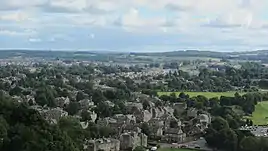




.jpg.webp)
